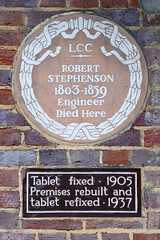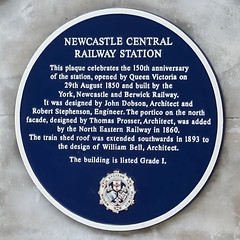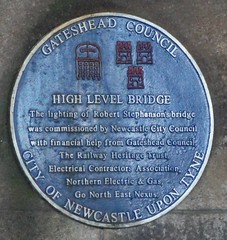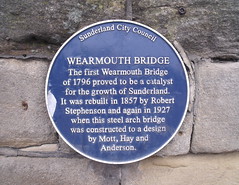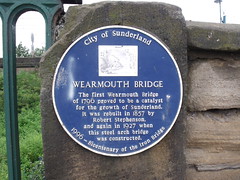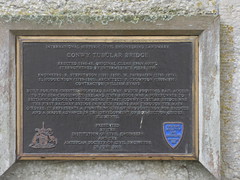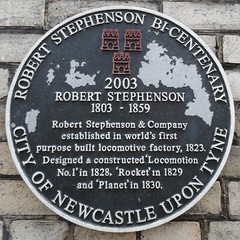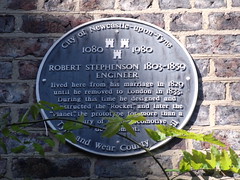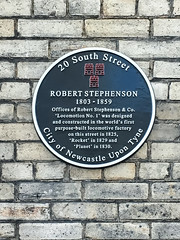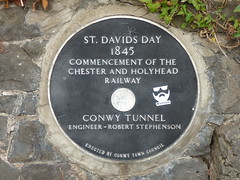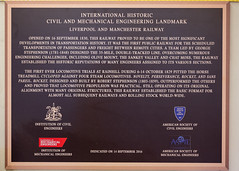Robert Stephenson
Commemorated on 16 plaques
Robert Stephenson (1803-1859), engineer, died here
35 Gloucester Square, London, United Kingdom where they died (1859)
High Level Bridge. George Stephenson, first surveyed routes to Berwick in 1838. His son, Robert, 1803 - 1859, designed this bridge. Rail deck opened in 1849 - a major link in a London-Edinburgh railway. The road deck opened in February 1850.
High Level Bridge, Gateshead, United Kingdom where they designed
Newcastle Central railway station. This plaque celebrates the 150th anniversary of the station, opened by Queen Victoria on 29th August 1850 and built by the York, Newcastle and Berwick Railway. It was designed by John Dobson, Architect and Robert Stephenson, Engineer. The portico on the north facade, designed by Thomas Prosser, Architect, was added by the North Eastern Railway in 1860. The train shed roof was extended southwards in 1893 to the design of William Bell, Architect. The building is listed Grade 1.
Newcastle Central railway station, Newcastle upon Tyne, United Kingdom where they designed
Robert Stephenson's Works The Stephenson Works on South Street in Newcastle housed the world's first purpose-built locomotive works. These building were the birth of the steam locomotive, which revolutionised the railway industry worldwide.
The Stephenson Works, 20 South Street, Newcastle upon Tyne, United Kingdom where they worked
Literary & Philosophical Society. Society established 1793. This building, designed by John Green, opened in 1825. Robert Stephenson was President of the Society, 1855 - 59.
23 Westgate Road, Newcastle upon Tyne, United Kingdom where they was president
Ware station. Built in 1843 for the Northern & Eastern Railway Company to the design of Robert Stephenson refurbished by British Rail in 1988.
Ware Railway Station, Station Road, Ware, United Kingdom where they designed
High Level Bridge. The lighting of Robert Stephenson's bridge was commissioned by Newcastle City Council with financial help from Gateshead Council, The Railway Heritage Trust, Electrical Contractors Association, Northern Electric & Gas, Go North East, Nexus.
High Level Bridge, Gateshead, United Kingdom where they was
Wearmouth Bridge. The first Wearmouth Bridge of 1796 proved to be a catalyst for the growth of Sunderland. It was rebuilt in 1857 by Robert Stephenson and again in 1927 when this steel arch bridge was constructed to a design by Mott, Hay and Anderson.
Wearmouth Bridge, Sunderland, United Kingdom where they built a bridge
Wearmouth Bridge. The first Wearmouth Bridge of 1796 proved to be a catalyst for the growth of Sunderland. It was rebuilt in 1857 by Robert Stephenson and again in 1927 when this steel arch bridge was constructed. 1996 - Bicentenary of the Iron Bridge
Wearmouth Bridge, Sunderland, United Kingdom where they built
Nodwedd Peirianneg Sipil o Bwysigrwydd Hanesyddol Rhyngwladol Pont Diwbaidd Conwy Codwyd 1846-48. Prif rychwant gwreiddiol 400TR. Cryfhawyd gan bileri canolig 1899. Peirianwyr: R. Stephenson (1803-1859), W. Fairbairn (1789-1874), E. Hodgekinson (1789-1861). Pensaer: F. Thompson (1808-1895). Contractor: William Evans. Adeiladwyd ar gyfer rheilffordd Caer-Caergybi oedd yn Cysylltu a'r llongau i'r iwerddon, yr oedd y bont hon yn rhagflabnu Pont Britannia dros y fenal hon oedd y bont reilffordd gyntg oedd yn galluogi trenau I basio o fewn y prif drawstiau. Dyma enghraifft arloesol o ddefnyddio haern oyr ac roedd yn gam pwysig ymlaen yn natblygaid trawstiau bogs. International Historic Civil Engineering Landmark Conwy Tubular Bridge Erected 1846-48. Original clear span 400ft. Strengthened by intermediate piers 1899 Engineers: R. Stephenson (1803-1859), W. Fairbairn (1789-1874), E. Hodgkinson (1789-1861). Architect: F. Thompson (1808-1895) contractor: John Evans. Built for the Chester-Holyhead railway, which provided rail access to the sea crossing to Ireland, this bridge was a forerunner to Robert Stephenson’s Britannia bridge over the Menai Strait. Conwy Tubular Bridge was the first railway bridge in which trains ran through the main girders. It represents a pioneering use of wrought iron for bridges and a major advance in the development of box-section girder elements.
English translation: International Historic Civil Engineering Landmark Conwy Tubular Bridge Erected 1846-48. Original clear span 400ft. Strengthened by intermediate piers 1899 Engineers: R. Stephenson (1803-1859), W. Fairbairn (1789-1874), E. Hodgkinson (1789-1861). Architect: F. Thompson (1808-1895) contractor: John Evans. Built for the Chester-Holyhead railway, which provided rail access to the sea crossing to Ireland, this bridge was a forerunner to Robert Stephenson’s Britannia bridge over the Menai Strait. Conwy Tubular Bridge was the first railway bridge in which trains ran through the main girders. It represents a pioneering use of wrought iron for bridges and a major advance in the development of box-section girder elements.
Conwy Tubular Bridge opposite the Suspension Bridge, Conwy, United Kingdom where they designed (1846-1848)
Robert Stephenson 1803-1859. Robert Stephenson & Company established in world’s first purpose built locomotive factory, 1823. Designed & constructed ‘Locomotion No.1’ in 1828, ‘Rocket’ in 1829 and ‘Planet’ in 1830.
South Street, Newcastle upon Tyne, United Kingdom where they worked
Robert Stephenson 1803-1859 Engineer lived here from his marriage in 1829 until he removed to London in 1833. During this time he designed and constructed the “Rocket” and later the “Planet”, the prototype for more than a century of steam locomotive development.
5 Greenfield Place, Westgate Road, Newcastle upon Tyne, United Kingdom where they lived
Robert Stephenson 1803-1859 Offices of Robert Stephenson & Co. ‘Locomotion No.1’ was designed and constructed in the world's first purpose-built locomotive factory on this street in 1825, ‘Rocket’ in 1829 and ‘Planet’ in 1830.
South Street, Newcastle upon Tyne, United Kingdom where they was
St. Davids Day 1845 Commencement of the Chester and Holyhead Railway Conwy Tunnel Engineer - Robert Stephenson
Mount Pleasant, Conwy, United Kingdom where they built (1845)
George Stephenson joined his son, Robert, and others building the Birmingham to London railway, for dinner at the Dun Cow hotel, on 23rd December 1837. Robert Stephenson was the engineer for the project and the dinner marked the completion of the Kilsby Tunnel. This plaque was placed on 25th March 1982 by the institution of mechanical engineers of which George and Robert Stephenson respectively, were the first two presidents.
Dun Cow, Daventry Road, Dunchurch, United Kingdom where they dined (1837)
International Historic Civil And Mechanical Engineering Landmark Liverpool and Manchester Railway Developments in transportation History. It was the first public railway for the scheduled transportation of passengers and freight between remote cities. A team led by George Stephenson (1781-1848) designed the 35-mile, double-tracked line. Overcoming numerous engineering challenges, including Olive Mount, The Sankey Valley and Chat Moss, the railway established the historic reputations of many engineers assigned to its various sections. The first ever locomotive trials at rainhill during 6-14 october 1829 pitted the horse treadmill cycloped against four steam locomotives. Novelty, Perseverance, Rocket, and Sans Pareil. Rocket, designed and built by Robert Stephenson (1803-1859), outperformed the others and proved that locomotive propulsion was practical. Still operating on its original alignment with many original structures, this railway established the basic format for almost all subsequent railways and rolling stock world-wide.
Station Road, Rainhill, United Kingdom where they was


